spring boot 與 thymeleaf (3): 設置屬性、條件、遍歷、局部變量、優先級、內聯語法
前面記錄了 thymeleaf 基本表達式, 這裏繼續看一下其他功能.
一. 設置屬性值
這裏的controller, html框架 還是沿用上一篇的部分.
html:
<div class="panel panel-primary"> <div class="panel-heading"> <h3 class="panel-title">設置屬性值</h3> </div> <div class="panel-body"> <!--從自定義屬性這裏看, html所有的屬性, 都可以通過 th:屬性名=的方式來寫--> <p th:elvin="${book.name}">1.自定義屬性 th : elvin</p> <!--attr設置屬性 attr可以設置任何屬性值, 但是一般不會用它設置所有屬性值--> <p th:attr="elvin=${book.name},title=${book.name}">2.attr設置屬性值</p> <!--一般html原來的屬性, 通過 th : 屬性名 的方式來使用 設置多個屬性: th : alt-title, th : lang-xmllang--> <p th:title="${book1.name}">3.html原來的屬性</p> <!--對於checked, disabled 這種的, 其判斷值的方式和 if 的方式一致, 具體在if中詳述 --> <input type="checkbox" th:checked="${book.price % 2 == 0}" th:disabled="${book.price % 2 == 0}" />a <input type="checkbox" th:checked="1" th:disabled="${book.price % 2 gt 0}" />b <input type="checkbox" th:checked="no" />c <!--classappend:可以添加class,而不會刪除之前的class styleappend:可以添加樣式,不會刪除之前的樣式,但是效果上會覆蓋之前的樣式--> <p class="pc" th:classappend="cp" style="border: 1px solid blue;background-color:red;" th:styleappend="‘background-color:#82af86;‘">4.追加class和style</p> <!--attrappend:在原有基礎的後面添加屬性值 attrprepend:在原有的基礎的前面插入屬性值--> <p title="原來的title" th:attrappend="title=‘ 添加的title‘" th:attrprepend="title=‘最前面的title ‘">5.前置,後置添加屬性值</p> <!--雖然這裏提供了事件設置的方式, 但是個人建議, 將事件綁定分離出去--> <p th:onclick="|console.log(‘${book.publishTime}‘)|">6.設置事件屬性</p> </div> </div>
結果展示:
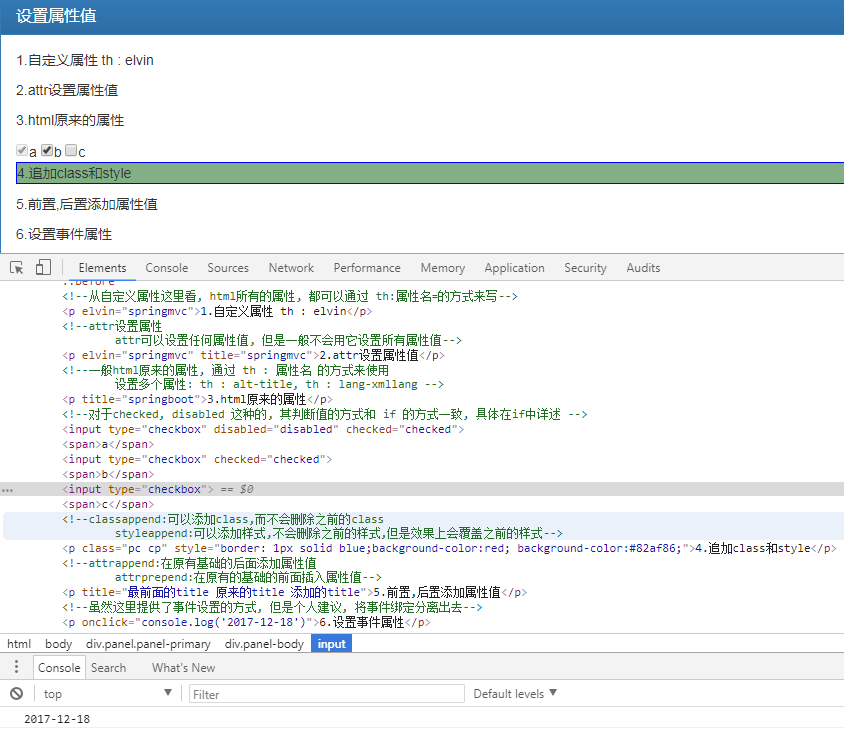
二. 條件運算
<div class="panel panel-primary"> <div class="panel-heading"> <h3 class="panel-title">條件運算</h3> </div> <div class="panel-body"> <!-- 這裏的 if判斷 作用有點類似javscript裏面的if 判斷通過的條件: 1.表達式的值不為null 2.如果為布爾值, 且為true : th:if="true" 3.不為0的數字, 負數也判定通過 4.不為‘0‘的字符 5.不為:"false","off","no"的字符串 --> <!--這裏的if unless 其實就相當於是 if else--> <p th:if="${book.price > 10000}" th:text="|本書單價為:${book.price / 100}元, 有點小貴|"></p> <p th:unless="${book.price > 10000}" th:text="|本書單價為:${book.price / 100}元, 價格可以接受|"></p> <p th:switch="${book.price}"> <span th:case="100" th:text="1塊錢"></span> <span th:case="${book.price}" th:text="${book.price / 100} + ‘元‘"></span> <span th:case="*" th:text="居然都不是, 只能選這個了"></span> </p> </div> </div>
if 和 unless 是相反的, 所以如果只有一個 if , unless確實可以當成是if對應的else來使用. 當然, 如果是 if - else if - else if - else也是可以實現的, 但是要嵌套進去, 不方便閱讀. 就不寫了.
switch裏面, case="*" 相當於java裏面的default, 只要有一個滿足條件, 別的都不會再顯示和判斷了.
結果展示:

三. 遍歷
數據準備: 在原來controller的方法下面繼續添加
List<Book> bookList = new ArrayList<>(); bookList.add(book); bookList.add(book1); bookList.add(new Book("bootstrap", new DateTime().toString("yyyy-MM-dd"), 11000L)); bookList.add(new Book("javascript", new DateTime().toString("yyyy-MM-dd"), 1020L)); model.addAttribute("bookList", bookList); Map<String, Book> map = new HashMap<>(); String pre = "index_"; for (int i = 0; i < bookList.size(); i++) { map.put(pre + i, bookList.get(i)); } model.addAttribute("bookMap", map);
html:
<div class="panel panel-primary"> <div class="panel-heading"> <h3 class="panel-title">列表List</h3> </div> <div class="panel-body"> <ul class="list-group"> <!--循環方法 這裏的item,自命名的,就相當於 bookList.get(index) iterInfo,自命名的, 是單條數據的補充信息, 比如裏面有 索引。 each可以叠代的對象: 1. 任何實現java.util.Iterable接口的對象 2. 任何實現java.util.Enumeration接口的對象 3. 任何實現java.util.Iterator接口的對象, 其值將被叠代器返回,而不需要再內存中緩存所有值 4. 任何實現java.util.Map的接口對象. 叠代時, iter變量將是 Entry類 5. 任何數組 6. 任何其將被視為包含對象本身的單值列表 --> <li class="list-group-item" th:each="item,iterInfo:${bookList}"> <span th:text="‘index:‘ + ${iterInfo.index}"></span> <span th:text="‘size:‘ + ${iterInfo.size}" style="margin-left:10px;"></span> <span th:text="‘count:‘ + ${iterInfo.count}" style="margin-left:10px;"></span> <span th:text="‘odd:‘ + ${iterInfo.odd}" style="margin-left:10px;"></span> <span th:text="‘even:‘ + ${iterInfo.even}" style="margin-left:10px;"></span> <span th:text="‘first item:‘ + ${iterInfo.first}" style="margin-left:10px;"></span> <span th:text="‘last item:‘ + ${iterInfo.last}" style="margin-left:10px;"></span> <span th:text="${item.name}" style="margin-left:10px;"></span> <span th:text="${item.price} + ‘分‘" style="margin-left:10px;"></span> <span th:text="${item.publishTime}" style="margin-left:10px;"></span> </li> </ul> </div> </div> <div class="panel panel-primary"> <div class="panel-heading"> <h3 class="panel-title">列表Map</h3> </div> <div class="panel-body"> <ul class="list-group"> <!--循環方法 這裏的item,自命名的,就相當於 bookList.get(index) iterInfo,自命名的, 是單條數據的補充信息, 比如裏面有 索引。 each可以叠代集合, 數組, Map(iter變量將是 Entry 類) --> <li class="list-group-item" th:each="item,iterInfo:${bookMap}"> <span th:text="‘index:‘ + ${iterInfo.index}"></span> <span th:text="‘size:‘ + ${iterInfo.size}" style="margin-left:10px;"></span> <span th:text="‘count:‘ + ${iterInfo.count}" style="margin-left:10px;"></span> <span th:text="‘odd:‘ + ${iterInfo.odd}" style="margin-left:10px;"></span> <span th:text="‘even:‘ + ${iterInfo.even}" style="margin-left:10px;"></span> <span th:text="‘first item:‘ + ${iterInfo.first}" style="margin-left:10px;"></span> <span th:text="‘last item:‘ + ${iterInfo.last}" style="margin-left:10px;"></span> <span th:text="${item.key}" style="margin-left:10px;"></span> <span th:text="${item.value.name}" style="margin-left:10px;"></span> <span th:text="${item.value.price} + ‘分‘" style="margin-left:10px;"></span> <span th:text="${item.value.publishTime}" style="margin-left:10px;"></span> </li> </ul> </div> </div>
結果展示:
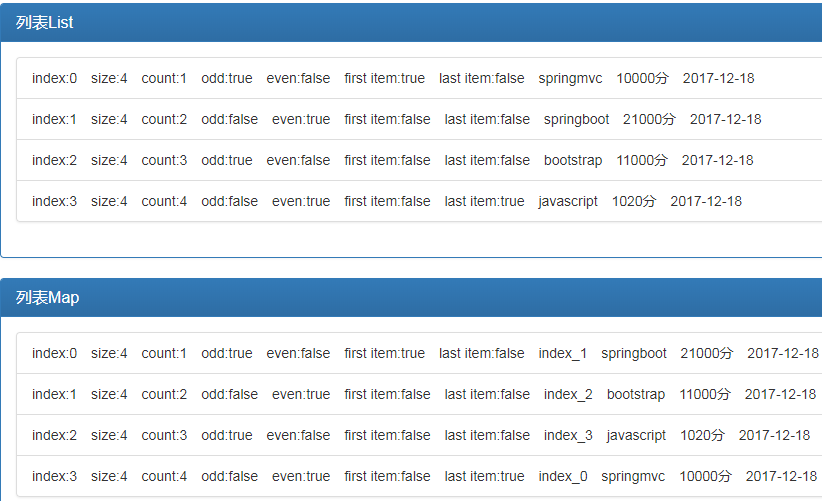
四. 局部變量
在each中, item:${list}, 這個item, 其實就是一個局部變量.
但是如果要定義自己的局部變量, 怎麽操作呢.
<div class="panel panel-primary"> <div class="panel-heading"> <h3 class="panel-title">局部變量</h3> </div> <div class="panel-body"> <!--1. 先來個簡單的--> <p th:with="first=‘123abc‘" th:text="${first}"></p> <!--2. 這裏two在前面, 如果從前往後, 肯定會報錯, 這裏能正常顯示, 說明標簽間有優先級--> <p th:text="${two.name}" th:with="two=${book}"></p> <!--3.多個變量的時候--> <p th:with="name=${book.name}, price=${book.price}" th:text="|${name} : ${price}|"></p> </div> </div>
結果展示:
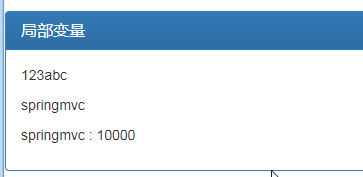
五. 優先級
在上一part中, 發現了, 在同一個tag中, th:with 和 th:text 的順序並不影響解析結果. 這肯定是有一個優先級順序在裏面
優先級從上往下, 逐漸變小
| Order | Feature | Attributes |
| 1 | Fragment inclusion | th:insert th:replace |
| 2 | Fragment iteration | th:each |
| 3 | Conditional evaluation |
th:if th:unless th:switch th:case |
| 4 | Local variable definition | th:object th:with |
| 5 | General attribute modification | th:attr th:attrprepend th:attrappend |
| 6 | Specific attribute modification | th:value th:href th:src ... |
| 7 | Text(tag body modification) | th:text th:utext |
| 8 | Fragment specification | th:fragment |
| 9 | Fragment removal | th:remove |
六. th:remove
這裏remove沒有出現過, 正好在這裏就看一下, remove 具體是要刪除什麽
<div class="panel panel-primary"> <div class="panel-heading"> <h3 class="panel-title">remove</h3> </div> <div class="panel-body"> <ul class="list-group" th:msg="all" th:remove="all"> <li>all-1</li> <li>all-2</li> </ul> <ul class="list-group" th:msg="body" th:remove="body"> <li>body-1</li> <li>body-2</li> </ul> <div class="list-group" th:msg="tag" th:remove="tag"> <ul> <li>tag-1</li> <li>tag-2</li> </ul> </div> <div class="list-group" th:msg="all-but-first" th:remove="all-but-first"> <p>all-but-first-1</p> <p>all-but-first-2</p> </div> <div class="list-group" th:msg="none" th:remove="none"> <p>none-1</p> <p>none-2</p> </div> </div> </div>
結果展示:
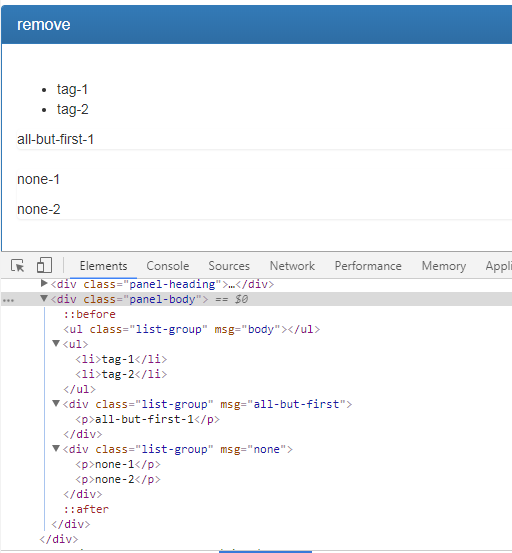
all: 將所有的都刪除掉了, 仿佛沒有出現過
body: 刪除標簽內部的內容
tag: 刪除標簽, 但是保留子項
all-but-first: 刪除除第一個以外的所有後代
none: 什麽都不做
七. 內聯語法
其實這個在上一篇已經出現過. 內聯語法, 主要是在模板中, 或者css, js中使用.
thymeleaf除了可以通過標簽來使用變量, 還可通過[[${...}]]的方式來使用.
1. 在css中, 想要使用變量
<style th:inline="css"> /*通過[ [ $ { }]]的方式訪問model中的屬性*/ .bgcolor { background-color: [[${color}]] } </style>
2. 在js中, 使用
<script th:inline="javascript"> $(function () { var book = [[${book}]]; console.log(book.name); });</script>
3. 在html中使用
<p th:inline="text">買了一本書:[[${book.name}]], 花了[[${book.price/100}]]塊錢</p>
不建議在標簽內容裏面這麽寫, 當然, 不利於原型的展示.
4. 禁用[[${...}]]
<p th:inline="none">買了一本書:[[${book.name}]], 花了[[${book.price/100}]]塊錢</p>
Demo:
<div class="panel panel-primary"> <div class="panel-heading"> <h3 class="panel-title">內聯語法</h3> </div> <div class="panel-body"> <!--1. css中使用--> <style th:inline="css"> .color{ background-color: [[${color}]]; } </style> <!--2. html 標簽內部使用--> <p th:inline="text" class="color">買了一本書:[[${book.name}]], 花了[[${book.price/100}]]塊錢</p> <!--3. html標簽內部禁用--> <p th:inline="none">買了一本書:[[${book.name}]], 花了[[${book.price/100}]]塊錢</p> <!--4. javascript中使用--> <script th:inline="javascript"> var book = [[${book1}]]; console.log(book); [# th:each="item:${bookList}"] console.log([[${item}]]); [/] </script> </div> </div>
結果展示:
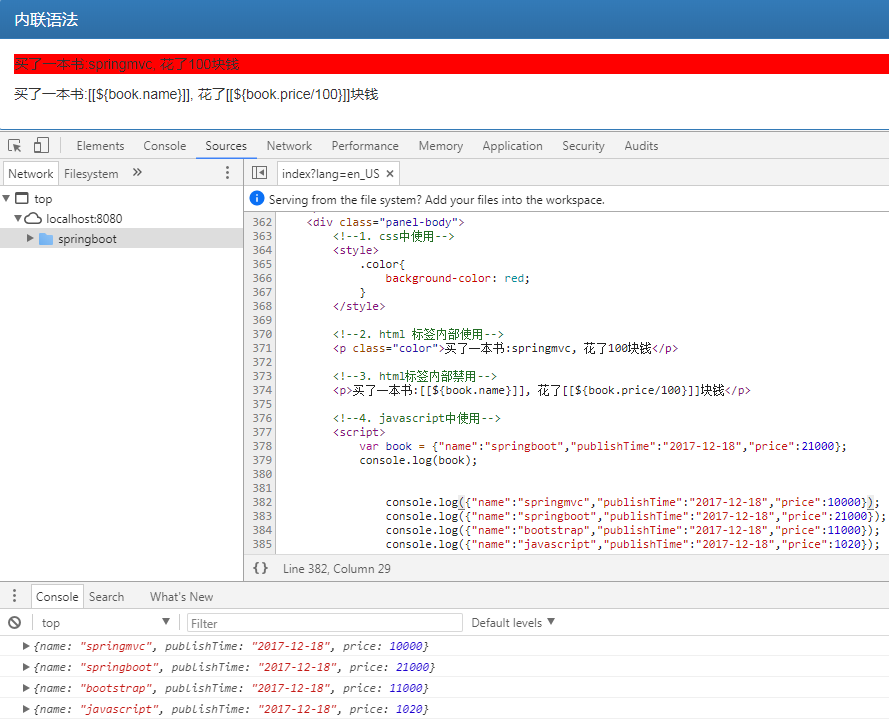
這裏有個 [# ] [/] , 可以當成是 標簽 來用. 是thymeleaf提供的
spring boot 與 thymeleaf (3): 設置屬性、條件、遍歷、局部變量、優先級、內聯語法
